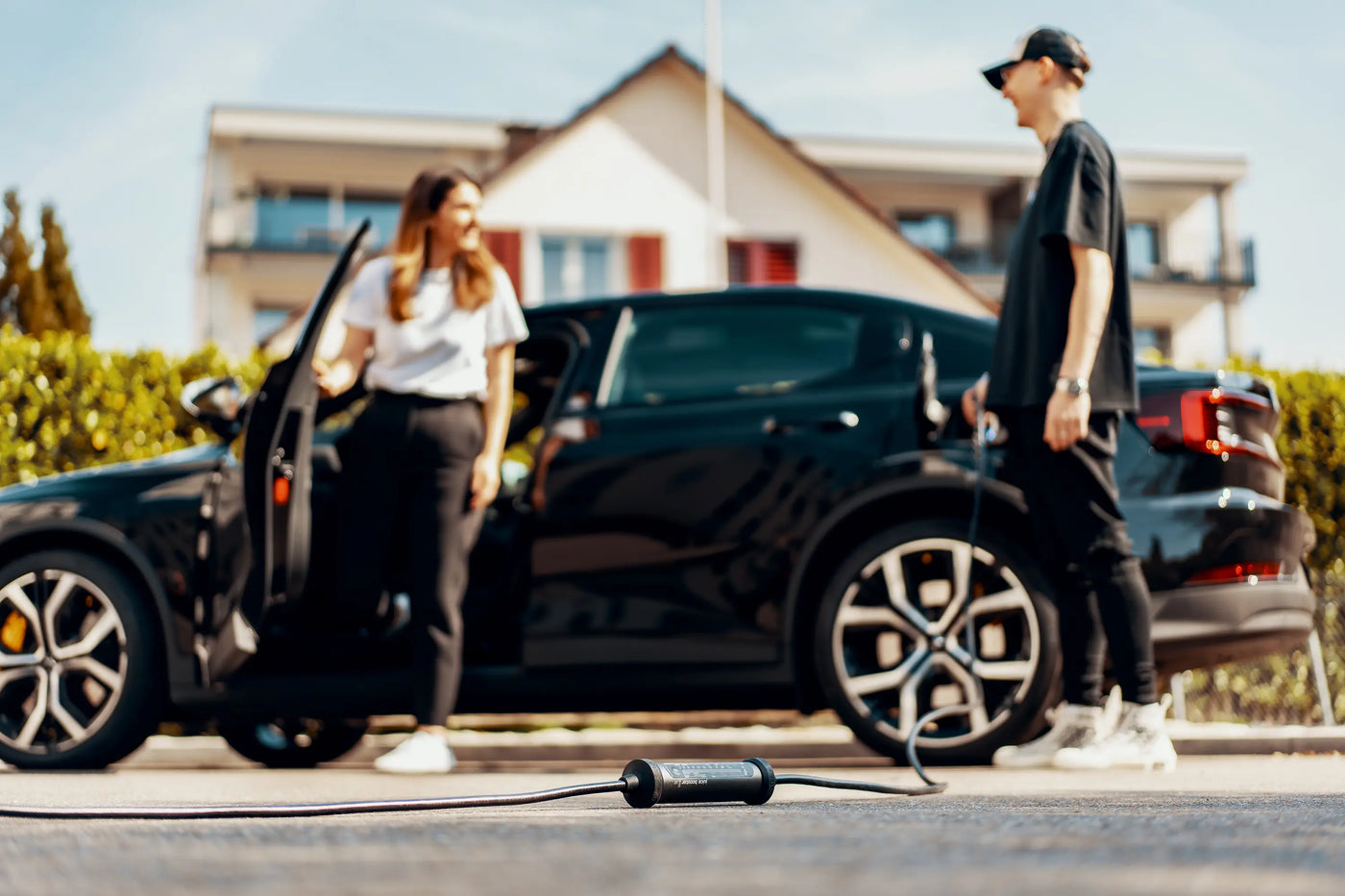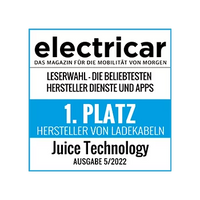Charging your electric car at home: What do I need to know?
Given the slow expansion of the public charging network and the generally cheaper electricity tariffs at home, convenient charging at home is just one of the many advantages that an electric car offers. However, in order to enjoy this freedom to the fullest, there are a few things to consider beforehand.
We have summarized the 8 most important questions and answers and explain in a beginner-friendly way in our basic knowledge article what you need to consider when charging at home.
The most important questions about charging at home:
- Simply charge your electric car at a power outlet?
- What power should my wallbox have – 11 or 22 kW?
- Is my supply line sufficient or do I need to upgrade?
- How long does it take to charge my electric car at home?
- How much does a wallbox and installation cost?
- What functions should my wallbox have?
- Is there an alternative to the permanently installed wallbox?
Question No. 1: Can you simply charge an electric car at a power outlet?
Not everyone wants to buy a wallbox straight away, especially since most electric cars come with so-called “emergency charging cables” as standard. However, for good reason, these should only be used in emergencies and not over a longer period of time on household sockets.
In principle, it is possible to charge an electric car using a household socket. However, this is not designed for a high continuous load over several hours, which can become a safety risk depending on the age and condition of the cable and contacts.
If you still want to charge at a household socket, this should only be done with a 100% standard-compliant charger such as the mobile wallboxes JUICE BOOSTER 2 or 3 air. These have an automatic power setting that is determined by the adapter used.
Another advantage is that the JUICE BOOSTER offers all the necessary safety features, such as active temperature monitoring and integrated residual current detection, which effectively triggers at the prescribed value and thus makes an expensive type B residual current circuit breaker unnecessary.
Question No. 2: What power should my wallbox have – 11 or 22 kW?
The maximum power with which an electric car can be charged is determined by the car. Most vehicles currently available on the market can be charged with a maximum of 11 kW.
It is also important to know which regulations must be complied with before installation - this varies from country to country. In Germany, the installation of an 11 kW wallbox simply has to be registered with the network operator. No further, complex approval process is necessary.
Things are different with a 22 kW wallbox. An additional permit must be obtained for this power class and this can take time. Registering an 11 kW wallbox therefore usually involves less administrative effort. Good news for anyone who likes things to be uncomplicated and doesn't want to deal with additional formalities!
Question No. 3: Is my supply line sufficient or do I need to upgrade?
The power supply in the house or garage is an important component and should of course be sufficiently dimensioned to provide the maximum charging power. For 11 kW, a three-phase supply of 400 volts and 16 amps is required.
To find out whether a suitable supply line for the high voltage is already available, a professional should be hired. This professional can also determine whether the installation of a residual current device (also known as a residual current device) is necessary. If a suitable supply line is already available, the electrician only needs to connect the wallbox to it to put it into operation. Wallboxes such as the JUICE CHARGER me 3 are pre-configured at the factory (plug & play) and are ready for use in no time.
Question No. 4: How long does it take to charge my electric car at home?
The time required for charging depends on several factors, such as the available power of the supply line and the remaining energy in the battery. The charging power is always determined by the "weakest link" in the charging chain.
Example:
A Tesla Model 3 has a battery capacity of 80 kWh and charges at a home wallbox with 11 kW.
Theoretically, a full charge would take just over seven hours: 80 kWh / 11 kW = 7.2 h.
In everyday life, however, you hardly ever run the battery completely empty, which is why charging usually takes much less time. The average distance a European travels per day is between 40 and 60 km - which, with an average consumption of 17 kWh per 100 km, can be recharged in less than 60 minutes using an 11 kW wallbox!
Important: Depending on the battery technology used, it is advisable to keep the charge level (so-called State of Charge or SoC) between 20% and 80% to protect the battery and extend its lifespan - you can find out more here.
Question No. 5: How much does a wallbox and installation cost?
It is difficult to estimate the costs as a general rule, as factors such as the materials (cables, desired wall box, circuit breaker) and the amount of work required (installation, possible wall penetrations) are crucial.
Important: Laying the cable and connecting a high-voltage socket or wall box should definitely be left to the professionals. A certified electrician will be able to assess the situation of the existing cables as well as the effort and costs involved during an on-site inspection.
Tip: Also ask your local authority about possible funding for the wallbox or its installation!
Question No. 6: What functions should my wallbox have?
An intelligent wallbox is not just a “better socket”, but a device with features that make the charging process safe, verifiable and controllable.
The following functions are important for an intelligent wallbox:
- RFID: Activation via RFID cards to identify users
- MID meters: For user-friendly, precise billing in semi-public areas
- Load management: For the dynamic distribution of power in several electric cars
- Communication with backend: power distribution, user management, station management and remote maintenance without additional devices
If the charging station is only to be used by selected people, it makes sense to activate it via RFID . This means that only those users who can identify themselves using an RFID card or tag can get electricity for their electric car, so that the energy consumption can be assigned to them.
If the wallbox is installed in a semi-public area (e.g. for tenants or homeowners in a garage), after activation via RFID, an integrated MID meter can be used to precisely break down which resident has used how much charging current for user-friendly billing.
If several electric cars are charged at the same time in a larger garage, a load management system is required. This ensures that the available power is distributed dynamically with just two cars and that the supply line is not overloaded.
Question No. 7: Is there an alternative to the permanently installed wallbox?
Would you like to be able to charge your electric car on the go just as safely as you are used to at home with a fixed wallbox?
The JUICE BOOSTER 2 and the JUICE BOOSTER 3 air are practical and mobile alternatives to permanently installed wall boxes. They offer the same safety and charging performance as a permanently installed wall charging station, with the advantage that they are also completely portable and can be used anywhere!
With the right adapter, any conventional socket becomes a charging option - whether at home or on the go. With the Type 2 adapter, your JUICE BOOSTER even becomes a Mode 3 charging cable for public charging stations.
The JUICE BOOSTER 3 air even offers the option of remotely controlling and monitoring the charging process using the "j+ pilot" app. In addition, up to ten devices can be operated simultaneously using the smartJUICE dynamic charging management. It is therefore also suitable for smaller, shared installations with multiple devices.
Good to know : With a mobile wallbox, installing a high-voltage socket is sufficient and at the same time more cost-effective than installing a fixed wall charging station. The JUICE BOOSTER 3 air can be connected to this with the red CEE16 adapter, for example, and charge at a full 11 kW.
The most important points summarized
Compared to public charging, charging at home can save both time and money once the charging solution is available.
Here again are the most important points you should know.
- Charging at household sockets should only be done in emergencies and only for a few hours, as these are not designed for such a high continuous load. However, it is still possible without any problems with standard-compliant wall boxes such as the JUICE BOOSTER, which has all the relevant safety features.
- Most electric cars can be charged with a maximum of 11 kW, which is why a wallbox with this power is sufficient for over 90% of vehicles.
- In order to be able to use the full power of a wallbox, an appropriate power supply must be available. An electrician is absolutely necessary for this. He can check on site whether the existing line is suitable, whether it needs to be extended or replaced and how much the installation will cost.
- Fully charging an electric car with 80 kWh battery capacity takes about seven hours at 11 kW charging power, although this is only necessary in very rare cases.
- Depending on the country, it must be checked whether a wallbox needs to be registered with the relevant authorities.
- The most important functions of a fixed wallbox include RFID activation, an MID meter, dynamic load management, an efficient backend and access to a web or mobile app.
- Alternatively, there are mobile charging solutions that – like the JUICE BOOSTER 3 air – are in no way inferior to fixed wall boxes in terms of performance and range of functions.
The choice of the right wallbox is entirely determined by your own needs. If you know the most important factors and your own driving and charging habits (at home or on the go), you can quickly find the ideal charging solution.













